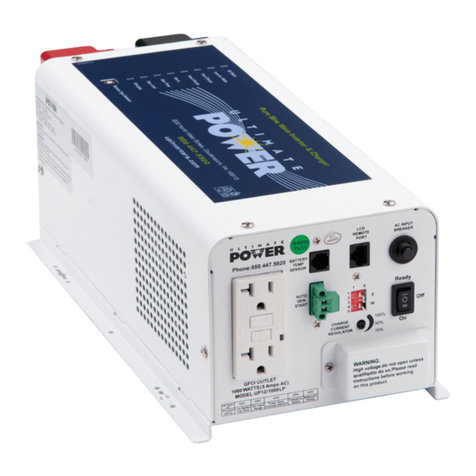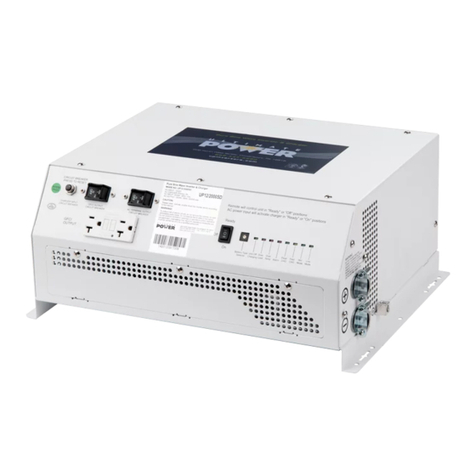
Ultimate Power www.upinverters.com
1 Important Safety Information
Save This Manual! Read this manual before installation, it contains important safety, installation
and operating instructions. Keep it in a safe place for future reference.
All wiring must follow the National Electric Code, Provincial or other codes in effect at the time
of installation, regardless of suggestions in this manual. All wires should be copper conductors.
1.1 General Safety Precautions
1.1.1 Before installing and using the LP Series Pure Sine Wave Inverter/Charger, read the manual and
cautionary markings on the Inverter/Charger enclosure. Be sure to read all instructions and cautionary markings
for any equipment attached to this unit. Installers must be certified technicians or electricians.
1.1.2 This product is designed for indoor/compartment installation. Do not expose the inverter/charger to rain,
snow, spray, bilge or dust. To reduce risk of hazard, do not cover or obstruct the ventilation openings. Do not
install the inverter/charger in a zero-clearance compartment. Overheating may result. Allow at least one inch of
clearance around the inverter for air flow. Make sure that the air can circulate freely around the unit. A
minimum air flow of 145CFM is required.
1.1.3 To avoid a risk of fire and electronic shock. Make sure that existing wiring is in good electrical condition;
and that wire size is not undersized. Do not operate the Inverter with damaged or substandard wiring.
1.1.4 This equipment contains components which can produce arcs or sparks. To prevent fire or explosion do
not install in compartments containing batteries or flammable materials or in locations which require ignition
protected equipment. This includes any space containing gasoline-powered machinery, fuel tanks, or joints,
fittings, or other connection between components of the fuel system. See Warranty for instructions on obtaining
service.
1.1.5 Do not dis-assemble the Inverter/Charger. It contains no user serviceable parts. Attempting to service the
Inverter/Charger yourself may result in a risk of electrical shock or fire. Internal capacitors remain charged after
all power is disconnected.
1.1.6 To reduce the risk of electrical shock, disconnect both AC and DC power from the Inverter/Charger before
attempting any maintenance or cleaning. Turning off controls will not reduce this risk
CAUTION: Equipment damage
The output side of the inverter’s AC wiring should at no time be connected to public power or a generator. This
condition is far worse than a short circuit. If the unit survives this condition, it will shut down until corrections
are made.
Installation should ensure that the inverter’s AC output is, at no time, connected to its AC input.
WARNING: LIMITATIONS ON USE
SPECIFICALLY, PLEASE NOTE THAT THE INVERTER/CHARGER SHOULD NOT BE USED IN
CONNECTION WITH LIFE SUPPORT SYSTEMS OR OTHER MEDICAL EQUIPMENT OR DEVICES.
WE MAKE NO WARRANTY OR REPRESENTATION IN CONNECTION WITH THEIR PRODUCTS FOR
SUCH USES. USING THE INVERTER/CHARGER WITH THESE PARTICULAR EQUIPMENTS IS AT
YOUR OWN RISK.





























